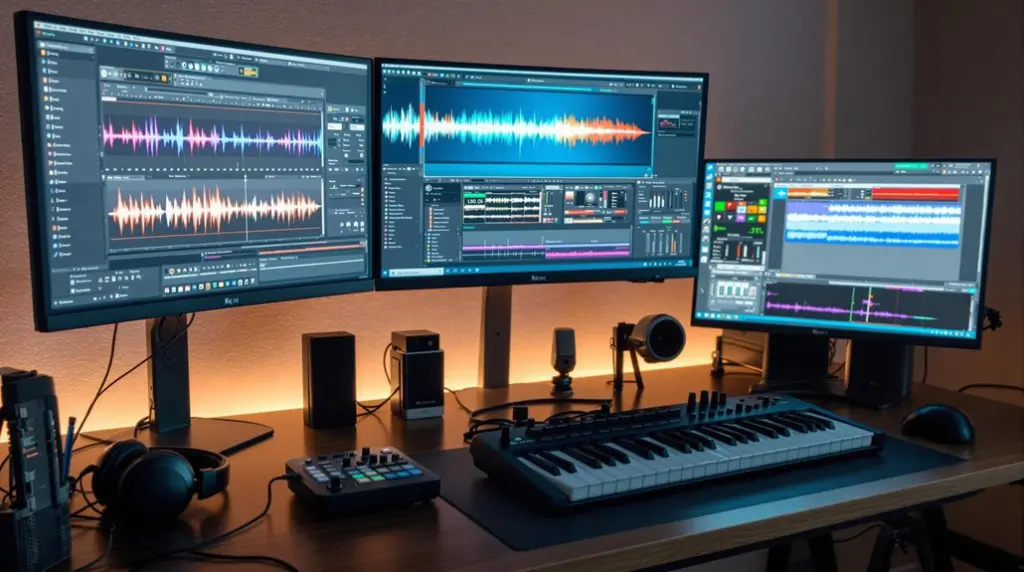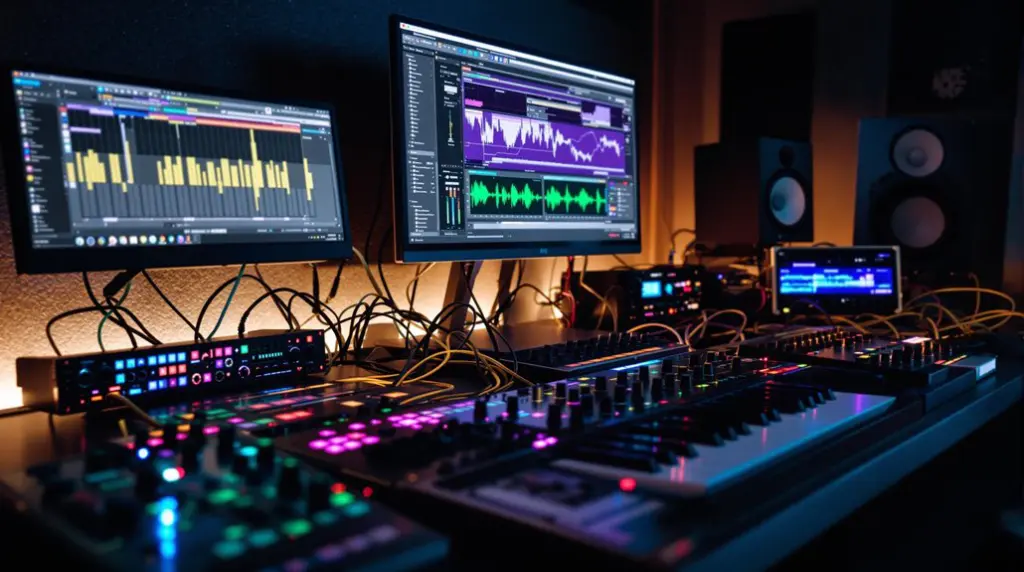The Roland MC-707 shines with its ZEN-Core engine, boasting over 3,000 Tone presets and 80 Drum kits for rich sound design. Its clip-based workflow, supporting up to 16 clips per track, allows dynamic compositions. The 16 velocity-sensitive RGB pads facilitate real-time sound triggering and clip launching. Extensive effects processing with 90 track and master effects provides thorough sonic sculpting. USB sample import enhances versatility by integrating external audio sources seamlessly. Explore further to discover how these features support both creative studio work and dynamic live performances, making the MC-707 a robust tool for any music producer.
Key Takeaways
- ZEN-Core Engine: The MC-707 features the ZEN-Core engine with over 3,000 Tone presets and 80 Drum kits for extensive sound design.
- Clip-Based Workflow: Supports 16 clips per track and 128 steps per clip, enabling dynamic and flexible arrangements.
- Velocity-Sensitive Pads: Includes 16 RGB velocity-sensitive pads for triggering sounds, launching clips, and real-time performance manipulations.
- Extensive Effects Processing: Offers 90 track and master effects, allowing for detailed sonic sculpting and modulation.
- Sample Import via USB: Facilitates easy integration of external audio sources, enhancing creative composition possibilities.
Historical Context and Market Position
The Roland MC-707, an advanced entrant in the long-standing MC series, represents the culmination of decades of innovation in music production technology. The MC series evolution began with the seminal MC-8 and MC-4 sequencers in the 1970s and 1980s, establishing Roland’s commitment to the integration of sequencing and sound synthesis.
The release of the MC-202 in 1983 marked the advent of the groovebox legacy, combining a monophonic synthesizer with a sequencer, which became a foundational model for subsequent innovations.
The late 1990s heralded a significant era for the MC series with the introduction of the MC-303, MC-505, MC-307, and D2. These models, utilizing the JV-1080 sound engine, expanded the capabilities and appeal of grooveboxes, cementing their place in electronic music production.
The MC-707, introduced as a modern groovebox, carries this legacy forward, designed to meet specific music production goals while competing with established products like the Akai MPC series. Additionally, the House of Kush offers tutorials on EQ and compression techniques, giving producers insights into maximizing the MC-707’s potential.
Positioned strategically within its price point, the MC-707 offers a sophisticated blend of synthesis and sequencing capabilities. This makes it an attractive option for both novice and seasoned producers, maintaining the MC series’ reputation for innovative and accessible music production tools.
Product Overview and Features
Showcasing impressive versatility, Roland’s MC-707 integrates the renowned ZEN-Core synthesis engine, offering an expansive palette with over 3,000 Tone presets and 80 preset Drum kits. This 8-track groovebox is engineered for advanced sound design, allowing musicians to explore a broad spectrum of sonic possibilities.
The clip-based workflow, reminiscent of Ableton Live, enhances workflow efficiency by enabling up to 16 clips per track and up to 128 steps per clip, thereby facilitating intricate arrangements and dynamic live performances. Furthermore, similar to VirtualDJ‘s compatibility with numerous controllers, the MC-707’s design guarantees seamless integration with other hardware setups.
The MC-707 features 16 velocity-sensitive RGB pads, which are instrumental in triggering sounds, launching clips, and utilizing the Scatter functionality for real-time manipulations. This allows producers to achieve intricate rhythmic patterns and elaborate soundscapes with ease.
In addition, the extensive effects processing capabilities—boasting 90 track and master effects—further augment its sound design prowess, enabling detailed sonic sculpting and real-time effects modulation.
Additionally, the unit supports sample import via USB, providing flexibility in integrating external audio sources into compositions. Despite its compact and ergonomic form factor, the monochrome display necessitates some menu navigation for advanced functions, which may occasionally impact workflow efficiency.
Nonetheless, the MC-707 remains a formidable tool for modern music production.
Technical Specifications and Usability
Building upon its versatile feature set, the Roland MC-707’s technical specifications and usability further underscore its prowess as a thorough music production tool. With dimensions approximating 41cm in width, the MC-707 offers a compact yet fully functional solution for producers, making it slimmer than many competitors within the groovebox market. The unit’s 16 pads are arranged in a 2×8 layout, providing a balance in pad size that enhances playability, situating itself comfortably between Elektron and Akai offerings.
The MC-707 supports a maximum of eight tracks per project, each track capable of holding up to 16 clips, allowing intricate and expansive arrangement capabilities. A notable consideration is the total sample memory, capped at 64 seconds for synth instruments, which may limit extensive sound design endeavors for users needing prolonged samples.
The user interface is designed for streamlined interaction, with all connectivity options such as two stereo outputs, a stereo effects send/return, and two inputs conveniently located on the rear panel. This setup guarantees ideal audio quality and efficient workflow.
| Specification | Detail | Comment |
|---|---|---|
| Dimensions | 41cm width | Slimmer than many competitors |
| Pad Layout | 16 pads in 2×8 layout | Enhances playability between Elektron/Akai |
| Tracks Per Project | 8 tracks, 16 clips each | Supports extensive arrangements |
| Sample Memory | 64 seconds for synths | Limited for extended sound design |
| Connectivity | 2 stereo outs, 2 inputs | Rear panel placement for streamlined setup |
The meticulous attention to technical specifications and usability makes the MC-707 a formidable tool in any producer’s arsenal.
Synthesis Engine and Sequencer Experience
Harnessing the power of the ZEN-Core synthesis engine, Roland’s MC-707 provides a robust platform for sound design, offering the flexibility to combine up to four oscillators, or partials, per tone.
This oscillator flexibility allows users to craft unique and complex timbres by blending standard waveforms or incorporating PCM samples. The intuitive modulation settings further enhance sound shaping, providing users with a versatile and user-friendly sound design experience.
Furthermore, the MC-707’s advanced MIDI sequencing capabilities align with the cutting-edge features found in top music production software, guaranteeing compatibility and ease of integration into any modern workflow.
The MC-707’s sequencer, rooted in the iconic x0x legacy, facilitates seamless pattern creation through its groups of 16 color-coded buttons.
This design guarantees straightforward step input, making it accessible for both novice and seasoned producers. Additionally, the sequencer’s motion sequence capability allows for real-time recording of knob movements, injecting dynamic elements into performances.
- Oscillator Flexibility: Combine up to four oscillators (partials) per tone.
- Pattern Creation: Utilize 16 color-coded buttons for easy step input.
- Motion Sequences: Record knob movements for dynamic performance.
- Track Limitations: Individual drum patterns require multiple tracks for varying lengths.
Integration, Performance, and Future Prospects
While the synthesis engine and sequencer capabilities of the Roland MC-707 lay a solid foundation for intricate sound design and pattern creation, its integration and performance aspects are equally essential for live setups and studio workflows.
The inclusion of two MIDI outs and stereo inputs greatly improves live connectivity, allowing seamless integration with other hardware in a performance environment. Additionally, stereo imaging techniques employed in mastering can also be relevant when setting up live sound environments with the MC-707, ensuring a wide and balanced soundstage.
However, limitations in gain staging when interfacing with consumer-level devices can impact audio quality, which is a vital consideration for professional applications.
User feedback has highlighted some operational challenges, particularly interruptions in audio output when loading new projects—a significant concern for live performances where uninterrupted sound is paramount.
Additionally, the design and button placement have been noted to impede efficiency, making quick adjustments more cumbersome during dynamic live setups. This could detract from the fluidity and spontaneity that many performers seek.
Looking ahead, users are optimistic about potential software updates that could address these issues. Enhancements, especially for looper tracks, could greatly boost the MC-707’s capabilities, ensuring it remains a versatile and reliable tool in both studio and live environments.
The prospect of these updates indicates Roland’s commitment to refining the user experience.
Frequently Asked Questions
How Long Is the Sampling Time for the MC 707?
The Roland MC-707’s sampling capabilities allow for a maximum individual sample time of 60 seconds per clip for Looper tracks. The advanced audio quality guarantees efficient composition, despite the sampling time constraints, facilitating seamless integration into professional workflows.
How Long Is the Pattern on the MC 707?
The pattern length on the Roland MC-707 can extend to a maximum of eight bars at 120 BPM. This allows for diverse pattern types, facilitating complex arrangements and detailed compositions within the device’s clip-based workflow.
What Size SD Card for Roland MC 707?
For ideal SD card compatibility and storage capacity with the Roland MC-707, utilize SDHC cards up to 32GB. Confirm the card is Class 10 or UHS-I rated for reliable performance and efficient data transfer rates.
Conclusion
The Roland MC-707 Groovebox represents a significant advancement in music production technology, combining a sophisticated synthesis engine, robust sequencer, and extensive integration capabilities. Its historical context and market positioning highlight its evolution and competitive edge. Technical specifications affirm its usability for both novice and professional users. The synthesis and sequencing features enhance creative workflows. Future prospects suggest continued relevance and adaptability in the ever-evolving landscape of electronic music production.




